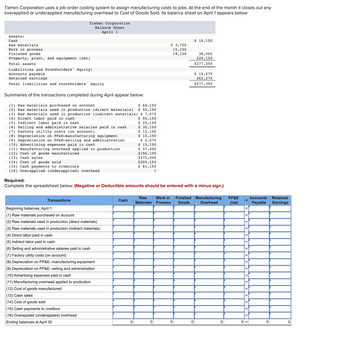
FINANCIAL ACCOUNTING
10th Edition
ISBN: 9781259964947
Author: Libby
Publisher: MCG
expand_more
expand_more
format_list_bulleted
Concept explainers
Topic Video
Question
H1.
Account

Transcribed Image Text:Tiehen Corporation uses a job-order costing system to assign manufacturing costs to jobs. At the end of the month it closes out any
overapplied or underapplied manufacturing overhead to Cost of Goods Sold. Its balance sheet on April 1 appears below:
Tiehen Corporation
Balance Sheet
April 1
Assets:
Cash
Raw materials
Work in process
Finished goods
Property, plant, and equipment (net)
Total assets
Liabilities and Stockholders' Equity:
Accounts payable
Retained earnings
Total liabilities and stockholders' equity
Summaries of the transactions completed during April appear below:
(1) Raw materials purchased on account
$ 66,150
(2) Raw materials used in production (direct materials) $ 50,150
$ 7,075
(3) Raw materials used in production (indirect materials)
(4) Direct labor paid in cash
$ 95,150
(5) Indirect labor paid in cash
$ 25,150
$ 30,150
$ 12,150
$ 10,150
$ 2,075
$ 15,150
$ 57,450
$196,150
$272,000
$205,150
$ 81,150
(6) Selling and administrative salaries paid in cash
(7) Factory utility costs (on account)
(8) Depreciation on PP&E-manufacturing equipment
(9) Depreciation on PP&E-selling and administration
(10) Advertising expenses paid in cash
(11) Manufacturing overhead applied to production
(12) Cost of goods manufactured
(13) Cash sales.
(14) Cost of goods sold
(15) Cash payments to creditors
(16) Overapplied (underapplied) overhead
Transactions
Beginning balances, April 1
(1) Raw materials purchased on account
(2) Raw materials used in production (direct materials)
(3) Raw materials used in production (indirect materials)
(4) Direct labor paid in cash
(5) Indirect labor paid in cash
(6) Selling and administrative salaries paid in cash
(7) Factory utility costs (on account)
(8) Depreciation on PP&E--manufacturing equipment
(9) Depreciation on PP&E--selling and administration
(10) Advertising expenses paid in cash
(11) Manufacturing overhead applied to production
(12) Cost of goods manufactured
(13) Cash sales
(14) Cost of goods sold
(15) Cash payments to creditors
(16) Overapplied (underapplied) overhead
Ending balances at April 30
Cash
0
?
Required:
Complete the spreadsheet below. (Negative or Deductible amounts should be entered with a minus sign.)
$3,750
15,150
19,150
0
$ 10,150
0
38,050
229, 150
$277,350
Raw Work in Finished Manufacturing
Materials Process Goods Overhead
0
$ 15,075
262,275
$277,350
0
PP&E
(net)
|=
=
0=
Accounts Retained
Payable Earnings
0
0
Expert Solution
This question has been solved!
Explore an expertly crafted, step-by-step solution for a thorough understanding of key concepts.
This is a popular solution
Trending nowThis is a popular solution!
Step by stepSolved in 3 steps

Knowledge Booster
Learn more about
Need a deep-dive on the concept behind this application? Look no further. Learn more about this topic, accounting and related others by exploring similar questions and additional content below.Similar questions
Recommended textbooks for you

 AccountingAccountingISBN:9781337272094Author:WARREN, Carl S., Reeve, James M., Duchac, Jonathan E.Publisher:Cengage Learning,
AccountingAccountingISBN:9781337272094Author:WARREN, Carl S., Reeve, James M., Duchac, Jonathan E.Publisher:Cengage Learning, Accounting Information SystemsAccountingISBN:9781337619202Author:Hall, James A.Publisher:Cengage Learning,
Accounting Information SystemsAccountingISBN:9781337619202Author:Hall, James A.Publisher:Cengage Learning, Horngren's Cost Accounting: A Managerial Emphasis...AccountingISBN:9780134475585Author:Srikant M. Datar, Madhav V. RajanPublisher:PEARSON
Horngren's Cost Accounting: A Managerial Emphasis...AccountingISBN:9780134475585Author:Srikant M. Datar, Madhav V. RajanPublisher:PEARSON Intermediate AccountingAccountingISBN:9781259722660Author:J. David Spiceland, Mark W. Nelson, Wayne M ThomasPublisher:McGraw-Hill Education
Intermediate AccountingAccountingISBN:9781259722660Author:J. David Spiceland, Mark W. Nelson, Wayne M ThomasPublisher:McGraw-Hill Education Financial and Managerial AccountingAccountingISBN:9781259726705Author:John J Wild, Ken W. Shaw, Barbara Chiappetta Fundamental Accounting PrinciplesPublisher:McGraw-Hill Education
Financial and Managerial AccountingAccountingISBN:9781259726705Author:John J Wild, Ken W. Shaw, Barbara Chiappetta Fundamental Accounting PrinciplesPublisher:McGraw-Hill Education


Accounting
Accounting
ISBN:9781337272094
Author:WARREN, Carl S., Reeve, James M., Duchac, Jonathan E.
Publisher:Cengage Learning,

Accounting Information Systems
Accounting
ISBN:9781337619202
Author:Hall, James A.
Publisher:Cengage Learning,

Horngren's Cost Accounting: A Managerial Emphasis...
Accounting
ISBN:9780134475585
Author:Srikant M. Datar, Madhav V. Rajan
Publisher:PEARSON

Intermediate Accounting
Accounting
ISBN:9781259722660
Author:J. David Spiceland, Mark W. Nelson, Wayne M Thomas
Publisher:McGraw-Hill Education

Financial and Managerial Accounting
Accounting
ISBN:9781259726705
Author:John J Wild, Ken W. Shaw, Barbara Chiappetta Fundamental Accounting Principles
Publisher:McGraw-Hill Education